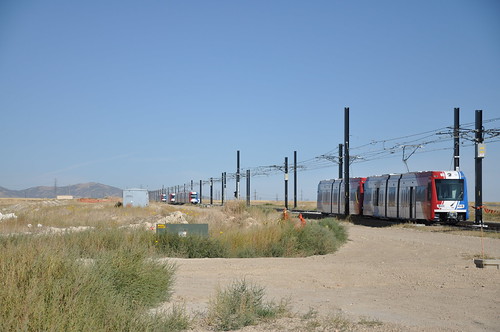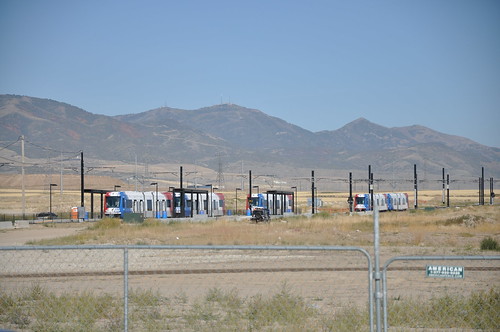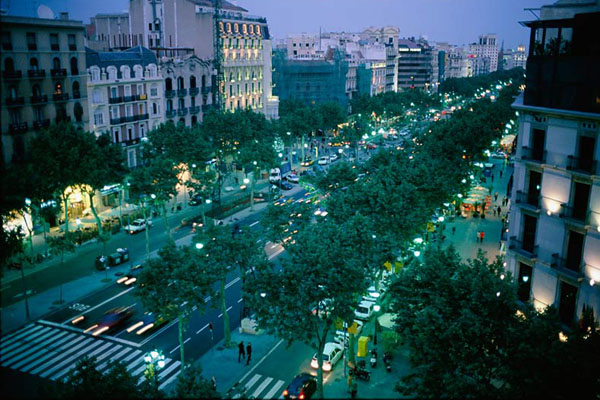If there is one thing we've learned over the last few decades, suburban political forces are a drain on cities. For everyone wants to be connected into the downtown and its vibrancy but at arms reach. So the wall was put up many years ago, you must have a car to get there. Now many are wondering if there is an easier way to get back downtown, wherever downtown is. And then they say, well it's too congested to drive, how can we get downtown to pay and appease the folks that want transit but aren't quite sure what it is they need. Then the answer comes, commuter rail.
It's a perfectly acceptable form of transit and has its place in the hierarchy, but for some reason regions get stuck on building rail and they look at what it will cost to do the first part right and they balk. How can we appease our overlords in the suburbs so they will give us something we in the city want in the future? Why do I say overlords? Because Metropolitan Planning Organizations and transportation providers as well as the congress is stacked with people who want to suck money out of cities and into their suburban and rural districts. The safe bet is to appease them right? Wrong.
What we've seen over the last ten years is the monumental failure of commuter rail to do any regional work of value as a first line. The millions of dollars for a couple thousand riders at best is
disheartening to those of us who want to see regional transit systems, not just a one and done. I've started to think about this with more clarity as the research comes in and I believe that the places who really are in it to win it will build destination based regional transit that connects a major employment corridor in the region. The headways need to be frequent and the line must run up the gut, not on the perimeter.
Houston's LRT Line

Here is the political reality facing regions today that don't have transit, especially in conservative or timid parts of the country. There seems to be this weird wishfulness that somehow commuter rail taking 2,000 people a day is exactly the way to cure congestion or spruce up economic development. However its basically a ticket to political backlash. Sure the line might have met ridership expectations but who cares? That's only 2,000 voters a day. How much induced voting demand did you create by freeing up room for 2,000 others cars on that freeway carrying 100,000 a day? Zero. It just means 2,000 more freeway voters can move into that district.
Here's what you can do. Put a light rail line down a major arterial between major destinations and all those haters that work downtown have to see the train pass them full at rush hour every day. When I was little my dad liked to play a joke on me that there were no boxcars in Bakersfield California. He still to this day will not acknowledge their existence because he knows it gets me really worked up. But the reason it got me really worked up is because I saw them in the yard downtown next to the high school ever single day. I saw them every day we would go pick up my sisters at school. If you saw a light rail train full of people at rush hour every day wouldn't you start to believe too? Once entrenched as something that works, no one pushes back, rather they want it in their part of town too. That is how systems get built.
But let's look again at why commuter rail is not the start.
1. It's got low ridership. These lines don't have that many people on them period. So people don't see the effects and they don't want more because they don't feel like they are missing anything. Lines like the Music City Star, Capital Metrorail, and Northstar are all carrying minuscule amounts of voters.
2. It's got low ridership because the schedules are bad and the schedules are bad because you're second fiddle to freight lines. If you're not giving commuters priority, why should they give you priority?
3. It was too easy. If a region builds a line because it was cheap to do, don't you think people are going to see through that and understand that you're not really putting a full effort in? I know I do. Indianapolis wants to build a cheap line because its politically feasible now. What about in 5 years. The harder the fight and the more work you put in, the more likely you'll be in good shape down the road. In running, you get out of your training what you put into it. I think the same applies here.
4. You're enabling the enemy. Same as the last point, but if you're not putting voters and supporters on the trains, you don't have a constituency for extensions or stopping service cuts.
Look at these lines according to the
Q4 ridership numbers, you can quibble with these a little bit as the agencies have different numbers in the news recently but 500 +/- riders isn't going to make a huge difference.
Recently Opened Commuter Lines
1. Northstar Twin Cities - 2,000
2. Capital Metrorail Austin - 800
3. Rail Runner New Mexico - 3,800
4. Music City Star Nashville - 800
5. Frontrunner Salt Lake - 5,400
6. Portland WES - 1,400
7. Oceanside CA - 4,100
Some of these places like Portland and Salt Lake City already have regional light rail systems so a Commuter Line connecting in isn't as bad of a decision for later when you have the internal network.
Single Destination Connecting Lines Opened in Last 10 years. Again the ridership differs due to gas prices but these are in the rough area of current reality
Houston - 34,600
Phoenix - 40,300
Minneapolis - 30,000
Charlotte - 14,000
Seattle - 24,700
Now the difference between people packed into trains running downtown as well as the number of carried voters is huge. It doesn't take a rocket scientist to tell you which ones are going to be more palatable for expansion. So instead of looking at the "cheapest" alternative, let's find the two major destinations in a region that need more capacity and need to be connected. This is what we should be thinking of when we're starting a system. No more commuter lines as regional rail starters.
 As an interesting side note, Broaddus' study noted that two ecosuburbs were the same except for parking provisions:
As an interesting side note, Broaddus' study noted that two ecosuburbs were the same except for parking provisions:
 And a more recent image in 2006
And a more recent image in 2006







 2006
2006 2009
2009











